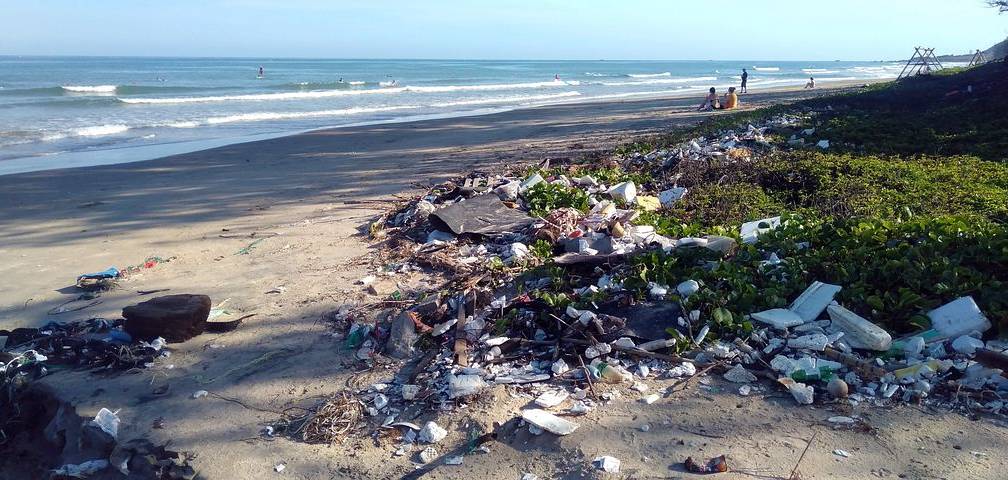
We’ve all seen the photos. Piles of plastic waste drifting in the open sea. A daily tide of plastic and other detritus washed up on our beaches. Scenes of turtles and fish tangled in discarded fishing nets. Yet all of it is preventable. This web report traces the problem of marine litter from source to sea to help policymakers and citizens understand what we can do about it.
Key messages
- Marine litter is defined as all human-made solid items that end up in the coastal or marine environment. The major cause is poor waste management and littering on land, although seaborne activities contribute to the problem.
- Land-based sources account for 80% of marine litter and approximately 85% of it is plastic. This is a big problem because of plastic’s impact on marine life and human health via the food chain. The persistent nature of plastic means that it can last up to 500 years in some cases.
- Plastic packaging and small plastic items comprise nearly 80% of plastic waste and are prevalent on European beaches. Although the amount of waste continues to increase, current waste management capacity is limited. Most plastic items that are used and thrown away are either recycled, incinerated or properly stored in waste facilities. However, a mismanaged part of that waste continues to pollute our seas.
- The waste that cannot be collected or properly managed eventually leaks into the environment and is carried to the seas by rivers. The outcome is that 75% of assessed marine areas are polluted.
- European plastic waste generation is growing at an even faster pace than economic growth. Continuous increasing waste generation is not in line with the EU’s goal of significantly preventing waste and reducing plastic waste.
- The EU zero pollution action plan, circular economy action plan (including its plastics strategy), Marine Strategy Framework Directive and Single-Use Plastic Directive all aim to curb the problem. Yet to achieve Europe’s green goals, we need a more holistic understanding of marine litter — from source to sea.
- The EEA identifies 10 recommendations at the end of this report to help policymakers and other stakeholders tackle the marine litter problem.
The big picture
Approximately 1 million plastic bottles are purchased every minute worldwide, and up to 5 trillion plastic bags are used every year (UNEP, 2018). Some of the waste enters European seas, where an estimated 626 million ‘floating items’ (or 3,382 tonnes of waste) accumulate annually (González-Fernández et al., 2021).
In Europe, demand for plastic continues to rise and more plastic waste is generated. The EU is not on track to meet its policy goal of significantly reducing waste as it moves towards its transition from a linear economy to a circular one.
The dirty secret behind marine litter is that we cause 100% of it and all of it is preventable
Actionable knowledge to tackle marine litter
Our seas, oceans and coasts are not the clean, natural places we want them to be. Yet they can be. In this report, the EEA aims to unfold where marine litter comes from, how it is transported by rivers and the magnitude of plastic pollution — so that stakeholders can better understand how to solve the problem.
The EEA plays a key role as a provider of independent information on the environment for policymakers and the general public. In the marine environment, a new Marine Litter Assessment Tool (MALT) that was produced by the ETC/ICM for EEA, can evaluate the state of plastic pollution in coastal regions. However, although most marine litter is generated on land, the reliability of waste management data is limited and plastic litter transported via rivers remains understudied. Clearly, we need to improve our data gathering and analysis on land and in rivers to better understand and tackle the problem.
This web report focuses on plastic packaging and small non-packaging plastic items (PPSI) as most marine litter is plastic. It captures the main findings of the Eionet ETC report, Marine litter in Europe: an integrated assessment from source to sea, which assesses the growing problem and the data needed to help solve it.
Can we fix the marine litter problem?
Marine litter has no easy fix. The majority of beach and marine areas show worrying signs of pollution. Plastic waste generation is not yet decoupling from gross domestic product (GDP) in the EU and total EU waste generation is still growing. However, economic growth does not have to result in more plastic waste in European seas.
In the Eionet ETC report, we can see the latest evidence and analysis of how our production and consumption habits are exerting pressure on European coasts and seas. Yet if we are going to tackle the problem of marine litter, we first need to understand where it comes from.
Policy highlight
Fully decoupling economic growth from raw material use by 2050 — as per the zero pollution and circular economy action plans — will be greatly challenged by the growing use of plastics and increasing overall consumption. We will have to recycle, reuse and dispose of our waste even better. A gradual improvement of waste management systems will not be enough.
References
European Environment Agency
González-Fernández, D. et al., 2021, Floating macrolitter leaked from Europe into the ocean, Nature Sustainability 4, pp 474-483 (https://doi.org/10.1038/s41893-021-00722-6) accessed 09 January 2023.
Plastics Europe, 2021, ‘Plastics — the facts 2021’, Plastics Europe (https://plasticseurope.org/knowledge-hub/plastics-the-facts-2021/) accessed 04 January 2023.
Plastics Europe, 2022, ‘Plastics — the facts 2022’, Plastics Europe (https://plasticseurope.org/knowledge-hub/plastics-the-facts-2022/) accessed 04 January 2023.
UNEP, 2018, ‘Our planet is choking on plastic’, United Nations Environment Programme (https://www.unep.org/interactives/beat-plastic-pollution/#:~:text=Around%20the%20world%2C%20one%20million,once%20and%20then%20thrown%20away) accessed 04 January 2023.
Posted on 2023-02-03 17:47








Comments